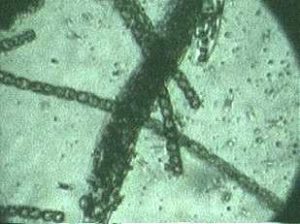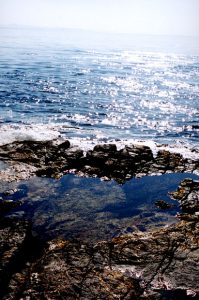 A general view of the pool.It is perched on a shelf which easily gets flooded when there is a slight swell in the ocean. A general view of the pool.It is perched on a shelf which easily gets flooded when there is a slight swell in the ocean. |
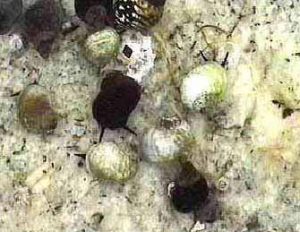 Polymorphism in the Snails of Pool # 4, Extended essay in Environmental Systems, Polymorphism in the Snails of Pool # 4, Extended essay in Environmental Systems, |
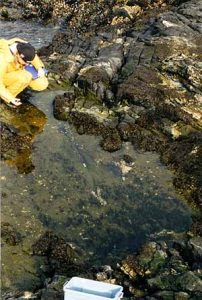 A student examines the life of pool 4 A student examines the life of pool 4 |
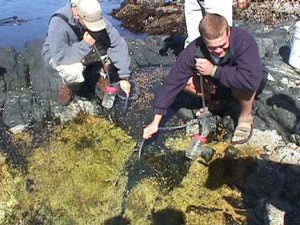 A A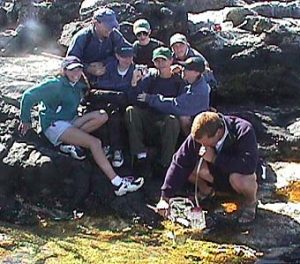 mphipods collected with a suction bottle from pool#4. mphipods collected with a suction bottle from pool#4. |
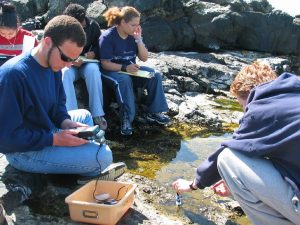 Roberto and the Biology Class measure salinity in pool 4.. May 2004 Roberto and the Biology Class measure salinity in pool 4.. May 2004 |
|
 Enteromorpha growing in the pool. May 2004. Enteromorpha growing in the pool. May 2004. |
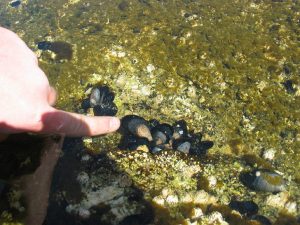 Bay mussels, Mytilus trossulus in the brackish water of Pool#4 Bay mussels, Mytilus trossulus in the brackish water of Pool#4 |
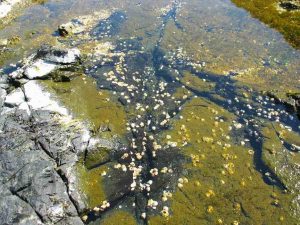 In May 2004,it is clear where the grazers, Littorina snails and amphipods) have trimmed off the diatoms on the bottom. In May 2004,it is clear where the grazers, Littorina snails and amphipods) have trimmed off the diatoms on the bottom. |
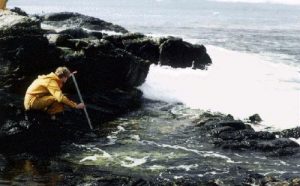 Arunas measures the depth of pool 4 while watching for swells Arunas measures the depth of pool 4 while watching for swells |
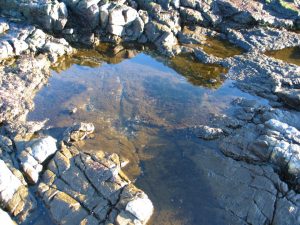 In February, 2007, the diatoms cover almost the entire bottom of the pool. This is the winter pattern. Grazing as shown above gradually removes the covering of diatoms. In February, 2007, the diatoms cover almost the entire bottom of the pool. This is the winter pattern. Grazing as shown above gradually removes the covering of diatoms.
|
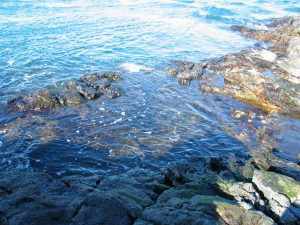 January, 2007. The tide is at its peak today, showing pool 4 being entirely submerged. January, 2007. The tide is at its peak today, showing pool 4 being entirely submerged. |
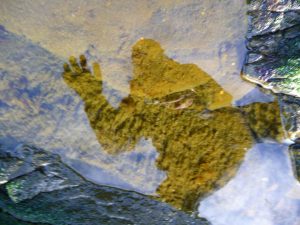 On February 11, 2008 a beast is photographed in the tidepool. On February 11, 2008 a beast is photographed in the tidepool. |
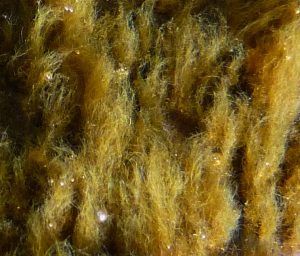 Close up of the Filamentous golden algae filling the tidepools in early spring. Close up of the Filamentous golden algae filling the tidepools in early spring. |
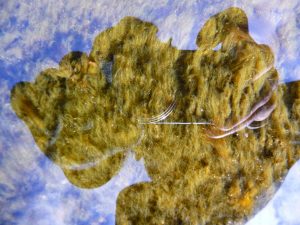 Weird form shades a covering of diatom fuzz! Weird form shades a covering of diatom fuzz! |
Some ideas to consider:
Invitations to Inquiry:
This pool is unique in a number of ways. The white substrate in the bottom of the pool is the result of a quartz intrusion that has flooded while molten, through the cracks of the basalt.
What is the effect of this white reflective surface on the temperature of the pool and the organisms that live in the pool?In 1997 while doing a detailed analysis of the organisms in the pool, we noticed for the first time that there were white periwinkles. At that time 26 were counted by Nadia and Catherine. Speculate on the evolutionary implications here.
The mussels in pool #4 are Mytilus trossulus, the bay mussel. Mussels that you can see on the surrounding intertidal areas are the Mytilus californianis. Why the species difference?
The pattern of diatom distribution changes in the bottom of the pool. In the winter, it covers the pool with a thick felt-like appearance, as spring approaches, the cover of diatoms starts to disappear, starting along the cracks where the mussels are anchored.. could one measure the rate of grazing from the amphipods in the cracks?
Temperature and Salinity in the pool fluctuate widely and at times form stratified layers. How does this affect organism distribution.?
The biotic and abiotic features of this pool vary considerably from other pools in the near vicinity. Quantify and explain the differences or similarities.
The only other pool that resembles this one is found over on the north-east corner of the island, at location peg15-pool #14. Compare the biotic and abiotic factors of these two pools, and explain the differences.
The following lab on tidepool abiotic factor measurement was done by Chiara Ravetti in September,2005.
Biology Laboratory
Analysis of the Abiotic Factors in Race Rocks Tidepools
The measurements of salinity, ph, and temperatures of different tidepools at Race Rocks was done September19, after 11.30 a.m., with high tide. For this reason the pools selected were only five, two (pool 7 and 8) several meters away from the sea at that time of the day, the other three (pool 1, 2 and 4) closer to the water and larger.
Data analysis and further note
| pool 1 | pool 2 | pool 4 | pool 7 | pool 8 | Ocean water | |
| Salinity | 62.1 | 32.8 | 21.9 | 45.3 | 45 | 30 |
| Temperature | 14.4 C | 14.4 | 14.2 | 15.4 | 15.2 | 10 |
| ph | 8 | 6.8 | 6.9 | 7 | 8 | — |
The measurement of salinity is expressed in parts per thousand; the instrument utilizes electricity, that passing through salt ions determines its quantity.
The pools were contaminated by sealions excrement, which reduced the visibility inside the pool and probably altered the pH of the water.
Other factors which might affect these values in a tidepool are: evaporation, precipitation, and in general pollution, scarce precipitation at that time of the year, the presence of the estuary, (The Strait of Juan de Fuca) with the influence of fresh water. The salinity in a tidepool is higher than the sea, for the evaporation and the little exchange of water, therefore the organisms living in it must tolerate high salinity, as well as variations in temperature. The smaller tidepools further from the sea present even more significant changes.

